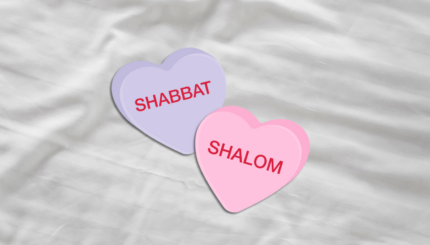The following d’var torah was given by Lindsay Simmonds at the first UK partnership minyan in November. To find out about how (and why!) to form a partnership minyan in your own community, sign up for the Live Video Webinar on the topic of partnership minyan, to take place on December 18, 8:30 EST.
Shlomo HaMelech in Proverbs 18 states that:
| יט אָח–נִפְשָׁע מִקִּרְיַת-עֹז ומדונים (וּמִדְיָנִים) כִּבְרִיחַ אַרְמוֹן. | 19 A brother offended is harder to be won than a strong city; and their contentions are like the bars of a castle. |
Even for those of us who enjoy the flourishing of partnership minyans, and who care for the minutiae of halakhic debate and its religious significance, we ought to be aware that these minyanim are a radical departure from normative Orthodox Jewish practice in the UK.
I’m not going to dance around the politics today. I’m diving in.
I want to touch on the notion of halakhic debate, and radical thought and practice in the UK for a few moments. But most significantly, I want to think about how we manage that debate and how we do not evoke anger, fracture or G-d forbid engender hatred between Jews – but rather foster an attitude of love and even religious pleasure in the eclectic ways of being a Torah Jew.
As I am sure many of you are aware there has been significant to-ing and fro-ing in the debate over attendance at the renowned annual, pluralistic Jewish learning conference, Limmud, these last few weeks. I believe that the way in which this issue has been handled, or mishandled, might shed light on our own journey; perhaps even give us perspective for a more dignified debate.
To be sure, historical evidence proves me wrong – the great Jewish debates over the centuries have caused enormous rifts, insurmountable fractures and left many labelled outcasts or apikorsim.
But I am annoyingly optimistic, almost determinedly naive.
I believe in negotiation and reconciliation. I believe that halakhah is always contemporary – and that is the point.
So, Chief Rabbi Mirvis announces that he will attend Limmud – which, according to those of mainstream UK Orthodoxy is a good, if not belated, step in the right direction, toward klal Yisrael, the unity of the Jewish community. It is a step that will allow Orthodoxy to be represented and as Rabbi Chaim Brovender once said, “to speak for itself.”
He was left to make his own decision by the current Beth Din, although they do not hold the same halakhic position. As they explained:
“The London Beth Din clearly retains its doubts about the cross-communal event and is not about to give Limmud its blessing. But, critically, the dayanim have indicated that they respect the chief rabbi’s viewpoint, even if they don’t share it.”
Again, a step in the right direction – we disagree, but we do not simply tolerate your differing position, we respect it.
However, following this seemingly amiable compromise, seven weighty halakhists strongly disagreed and made their position public through a communal announcement:
“Participation in [Limmud’s] conferences, events and educational endeavours blurs the distinction between authentic Judaism and pseudo-Judaism and would bring about tragic consequences for Anglo-Jewry. As such we strongly advise any Jew whose heart has been touched by the fear of G-d, and who wishes to walk upon paths which will be viewed favourably by the Ribono shel Olam, not to participate in any activity which is under the auspices of Limmud or similar organisations.”
Care is taken to not mention the Chief Rabbi by name, or to state that going to Limmud is assur – forbidden; but there is seemingly a lack of respect, even tolerance, for the choices that other Orthodox rabbis and leading figures have made – not to mention a Chief Rabbi and his Beth Din.
This public announcement caused furor amongst the mainstream Orthodox lay leaders who responded with their own public letter of complaint:
“…we warmly welcome the Chief Rabbi’s decision to attend Limmud. It is a decision that is consistent with the best traditions of Anglo-Jewish Orthodox rabbinic leadership – namely promoting an open, approachable and inclusive Judaism while adhering to a firm halachic framework. However, we deeply regret the publication of a formal Gilui Da’at (Declaration of Opinion) by a number of Orthodox rabbis which claims that those who attend Limmud will, by implication, not be viewed favourably by God. The declaration has the potential to cause great harm to our community and appears to be rooted in tactical power play, as opposed to religious principle.”
And subsequently further responses to the Gilui Da’at have come out, including from Rabbi Nathan Lopes Cordozo, suggesting that:
“To a great extent, authentic Judaism consisted of a multitude of seriously competing ideas, and while simultaneously not compromising Halacha there was a full awareness among the Sages that even Halacha was open to many opinions.”
It continues:
“Real Orthodoxy has nothing to fear. It has all the vital ingredients necessary to enter the battlegrounds and show its worth. Judaism is the most astonishing and daring religion with which the world has been blessed. It has infinite courage, standing head and shoulders above everything else. It dares, and never avoids any obstacle or critique. It enjoys a good fight so that it can enrich itself. It is a protest movement against many “isms,” but above all against small-mindedness.”
This is the theme upon which I want to elaborate for two reasons.
One, because we need to be clear about the consequences of such small mindedness – from wherever it emerges and
Two, because small-mindedness seems to me to be an obsession with the past, a desperate attempt to remain in the present and a fear of what the future may hold.
Small-mindedness emerges from a lack of imagination, a lack of appreciation of “other,” and a lack of the perception that the passing of time and the hidushim (insights) – the changes it brings are a healthy and necessary part of our religious landscape.
Contradistinctively, Rosh Chodesh is about the celebration of renewal through age-old customs. It is about the recognition of the passing of time, of what we ask the future to hold; but indicative too of how the ancient moon, although it waxes and wanes remains a constant presence.
Famously, we are told, it was a particular gift to women – in recognition of both
- their sensitivity to the ongoing passage of time and
- their specific ability not to fear the future
This is highlighted in the experiences of the chet he’egel – the golden calf in which the women refused to participate; the slavery in, and the exodus from Egypt – all three of which revolved around an appreciation of time.
Moshe will return down the mountain, even if you have calculated that he is late; we will eventually leave Egypt, even if that imaginative faithful leap seems so unlikely now; and the exodus will generate a moment to sing, to express thanksgiving.
All of these events are motifs for sitting it out; for living with the ambivalence of both the desperate need for an alternative reality whilst recognizing that the creation of something new is a process.
Notably, only 2 out of the 26 lay leaders who signed that public letter were women; There has never been a female Chief Rabbi; There are no women who sit on the Beth Din. But there are plenty of women here today – taking part and being present; and plenty of men who are working together with them; perhaps a taste of things to come, but also a taste of how newness might emerge.
Yesterday’s parsha is one of the archetypal moments of fracture. Two brothers, Esau and Jacob, develop – through choice or destiny, into brothers, into nations who abhor each other. Their quest for inheritance and for blessing, disabling their ability to see each other’s needs and to recognize each other’s creative possibilities, has remained an ongoing war, an everlasting chasm.
In his introduction to the Book of Genesis, the great 19th-century scholar The Netziv suggests that the destruction of the two Temples came about because:
“The people of that generation of the Second Temple were “righteous,” “pious,” and intensely involved in Torah study. However, they were not upright in their relationships with others, either in their actions, thoughts, or speech. Therefore, because of the unwarranted hatred each had for the other, one would falsely accuse another of heresy, simply because the “other’’ religious expression, and way of respecting and showing reverence to GOD, was not in accordance with one’s own way. The one whose way was different was thereby labeled a non-believer and considered cut off from authentic Judaism, even though that person fulfilled The Torah’s Commandments.This lack of tolerance and limited acceptance of individual religious expression eventually led to murder in the first degree and to all the evils in the world. Eventually, GOD felt that punishment – the destruction of the Holy Temple – was necessary.”
In other words, he blames these two destructions on “excessive righteousness, that is “righteous” individuals who treated others who did not exactly conform to their beliefs as heretics… a particular form of sinat chinam (baseless hatred).”
Baseless, because we as Jews believe in a good argument for the sake of heaven; and hatred, because of the ongoing and occasionally irreparable gulf that is created between ourselves.
Given that in this month of Kislev, of Hanukkah, the Hashmonaim worked for the sake of heaven and not themselves, they rejected the Greek notion of Hellenism and the worship of the body – and persisted in the worship of one G-d; I would like to suggest that we take from their example the possibility of serving G-d with passion and conviction, whilst being ever wary of those who do not hold our views nor practice our innovative rituals.
I hope that, unlike Limmud-gate, we Partnership Minyan-ers might endeavour and succeed in being a far better example of generating the age-old Jewish ideal of a good argument, whilst retaining not just our respect for, but our love of, those who disagree.
To find out about how (and why!) to form a partnership minyan in your own community, sign up for the Live Video Webinar on the topic of partnership minyan, with Dr. Tova Hartman, Dr Chaim Trachtman, and others, set to take place on December 18, 8:30 EST.
JOFA will be offering a series of sessions at Limmud UK later this month on subjects relating to gender in Jewish life. Check out the full schedule here.
The Jewish world is full of debates. Get the latest in MyJewishLearning’s weekly blogs newsletter.
halachic
Pronounced: huh-LAKH-ic, Origin: Hebrew, according to Jewish law, complying with Jewish law.
minyan
Pronounced: MIN-yun, meen-YAHN, Origin: Hebrew, quorum of 10 adult Jews (traditionally Jewish men) necessary for reciting many prayers.
Torah
Pronunced: TORE-uh, Origin: Hebrew, the Five Books of Moses.



